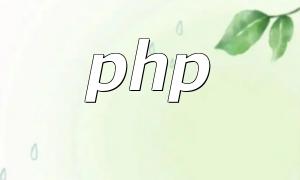With the continuous growth of the Internet, online forums have become essential spaces for people to communicate, share ideas, and exchange information. Whether it's a hobby community, a professional knowledge-sharing platform, or a personal blog system, forums offer a free and open environment for discussion. This article introduces how to build a simple forum system using PHP, explaining its fundamental principles and implementation process.
Before we start coding, it’s important to define the essential features of a forum: user registration, login, posting, replying, editing, and deleting posts. To support these operations, we’ll design a database to store user and post data efficiently.
We’ll use MySQL as our relational database. First, create a database named “forum”, and then add two tables:
You can easily create these tables using a database management tool such as phpMyAdmin.
PHP provides built-in functions to connect and interact with MySQL. Below is a simple example:
<?php
$servername = "localhost";
$username = "root";
$password = "123456";
$dbname = "forum";
$conn = mysqli_connect($servername, $username, $password, $dbname);
if (!$conn) {
die("Database connection failed: " . mysqli_connect_error());
}
echo "Connected successfully";
?> Once the connection is established, you can perform operations such as inserting, querying, or updating data.
User registration is one of the core features of any forum. PHP can handle form input and insert the new user record into the database:
<?php
if ($_SERVER['REQUEST_METHOD'] == 'POST') {
$username = $_POST['username'];
$password = md5($_POST['password']); // Simple encryption example
$check = mysqli_query($conn, "SELECT * FROM users WHERE username='$username'");
if (mysqli_num_rows($check) > 0) {
echo "Username already exists. Please choose another.";
} else {
mysqli_query($conn, "INSERT INTO users (username, password) VALUES ('$username', '$password')");
echo "Registration successful";
}
}
?> Always validate and sanitize user input to prevent SQL injection and ensure data security.
The login function verifies the user’s credentials and creates a session upon success:
<?php
session_start();
if ($_SERVER['REQUEST_METHOD'] == 'POST') {
$username = $_POST['username'];
$password = md5($_POST['password']);
$result = mysqli_query($conn, "SELECT * FROM users WHERE username='$username' AND password='$password'");
if (mysqli_num_rows($result) > 0) {
$_SESSION['user'] = $username;
echo "Login successful";
} else {
echo "Invalid username or password";
}
}
?> Once logged in, the user’s session can be used to identify them when posting or replying to threads.
After logging in, users can create new posts by submitting a form. The script will store the post data and associate it with the logged-in user:
<?php
session_start();
if (isset($_SESSION['user'])) {
$title = $_POST['title'];
$content = $_POST['content'];
$username = $_SESSION['user'];
$user_query = mysqli_query($conn, "SELECT id FROM users WHERE username='$username'");
$user = mysqli_fetch_assoc($user_query);
$user_id = $user['id'];
mysqli_query($conn, "INSERT INTO posts (user_id, title, content) VALUES ('$user_id', '$title', '$content')");
echo "Post created successfully";
}
?> On the post detail page, users can submit replies that are stored in the database and linked to the corresponding post. This allows a threaded discussion format typical of online forums.
After building the core system, you can extend your forum with additional features such as:
It’s also important to implement security enhancements such as input validation, password encryption, and SQL injection protection to maintain system stability and data safety.
In this tutorial, we demonstrated how to develop a simple PHP-based forum system, including database design, user management, and post handling. By following these steps, beginners can gain a solid understanding of how dynamic websites operate. With further optimization, this basic forum can be expanded into a complete community platform.









